Creativity, Innovation: Mobile Communication & Adidas Strategies
VerifiedAdded on 2023/06/11
|11
|2277
|268
Essay
AI Summary
This essay provides an overview of creativity and innovation in two distinct areas: mobile communication technology and Adidas' business strategies. Part A traces the evolution of mobile wireless technology from 1G to 4G, predicting future changes in mobile communication over the next 10 to 100 years, including the rise of 5G, increased data rates, and the integration of wireless technology with robotics and automated transport. Part B examines Adidas' response to climate change, a significant challenge for its supply chain, highlighting initiatives like the Better Cotton Initiative, Sustainable Apparel Coalition, and the DryDye technology. The essay also discusses Adidas' resurgence after a period of losses, attributing its success to leveraging its heritage, understanding consumer behavior, and fostering a culture of innovation driven by its founder's philosophy. The analysis demonstrates how both technological advancements and strategic business adaptations are crucial for navigating future challenges and opportunities.
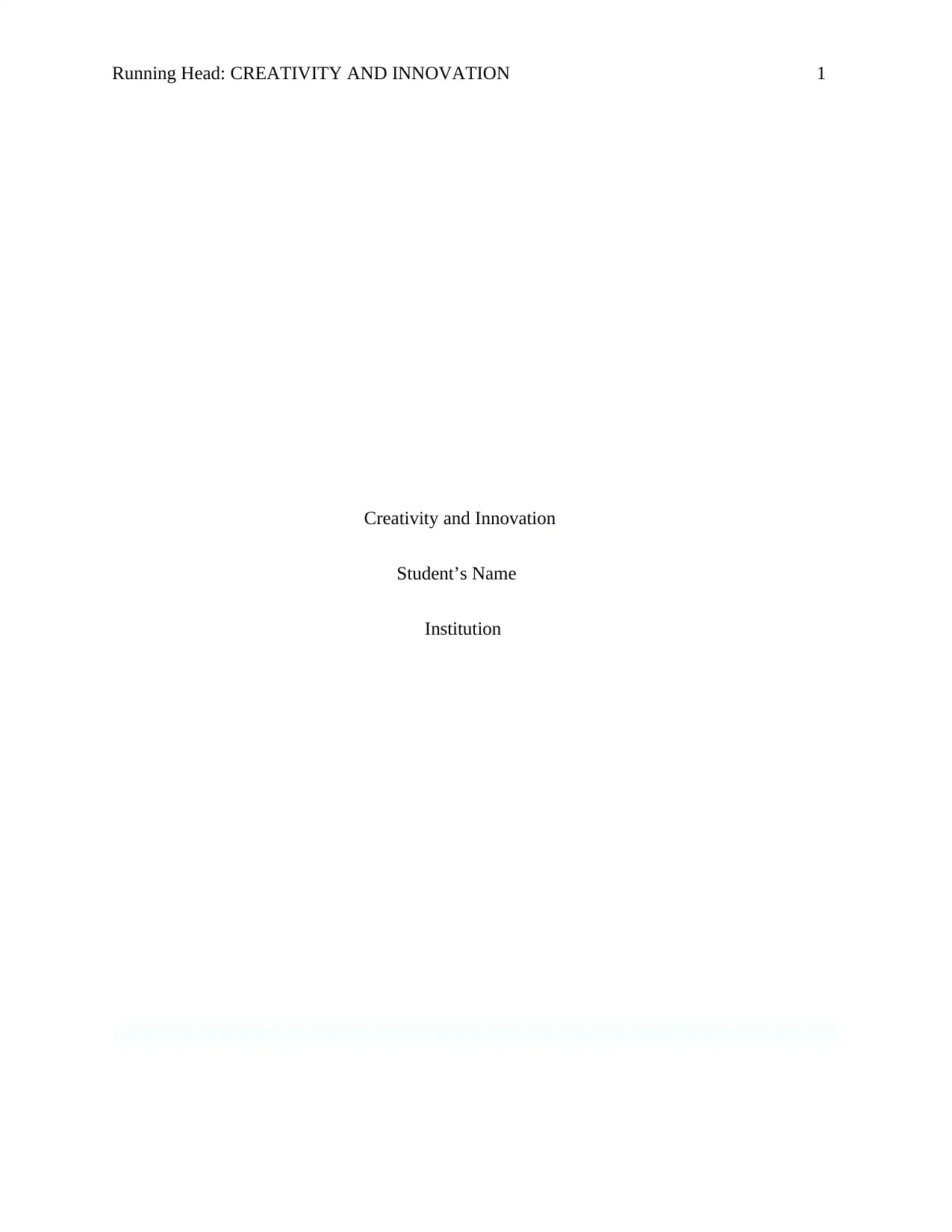
Running Head: CREATIVITY AND INNOVATION 1
Creativity and Innovation
Student’s Name
Institution
Creativity and Innovation
Student’s Name
Institution
Paraphrase This Document
Need a fresh take? Get an instant paraphrase of this document with our AI Paraphraser
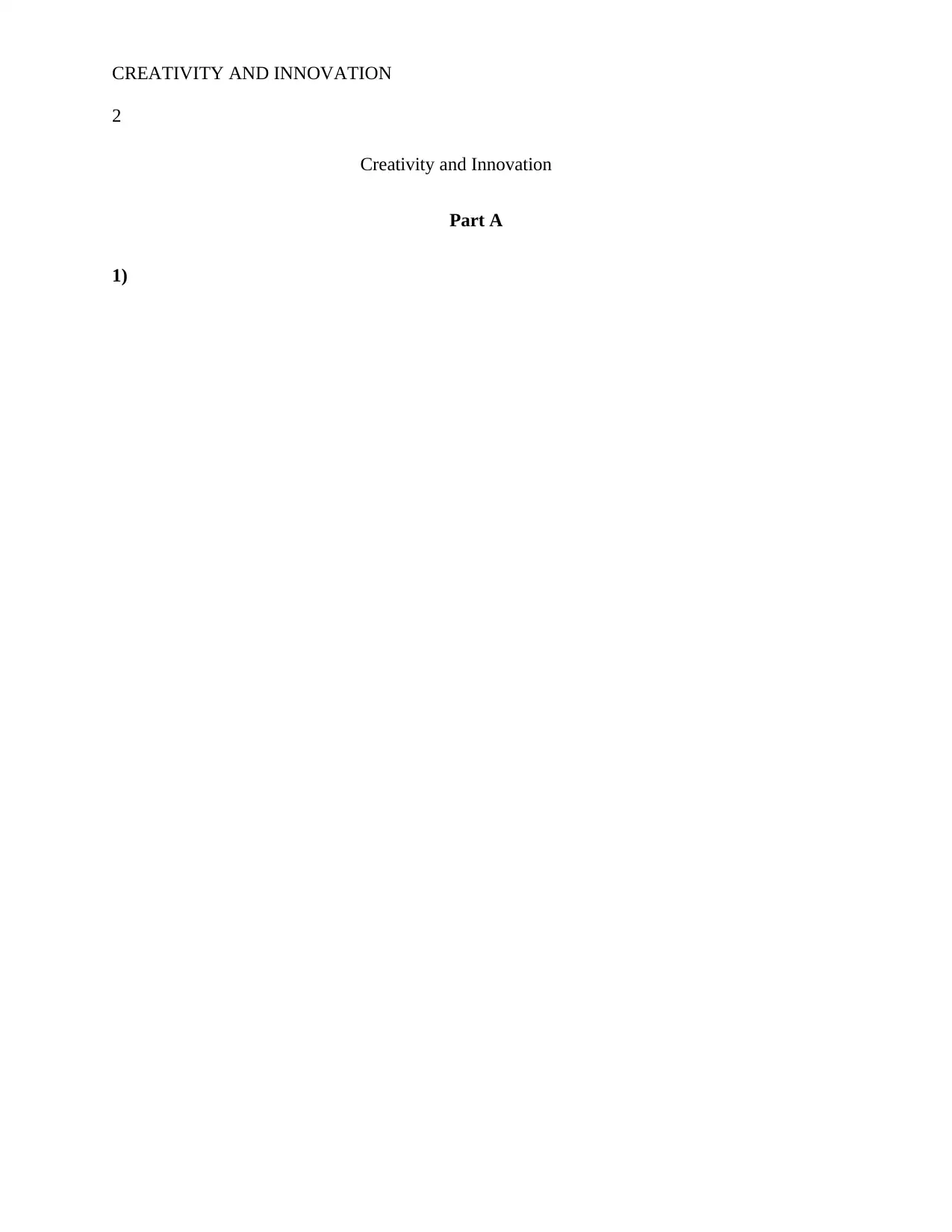
CREATIVITY AND INNOVATION
2
Creativity and Innovation
Part A
1)
2
Creativity and Innovation
Part A
1)
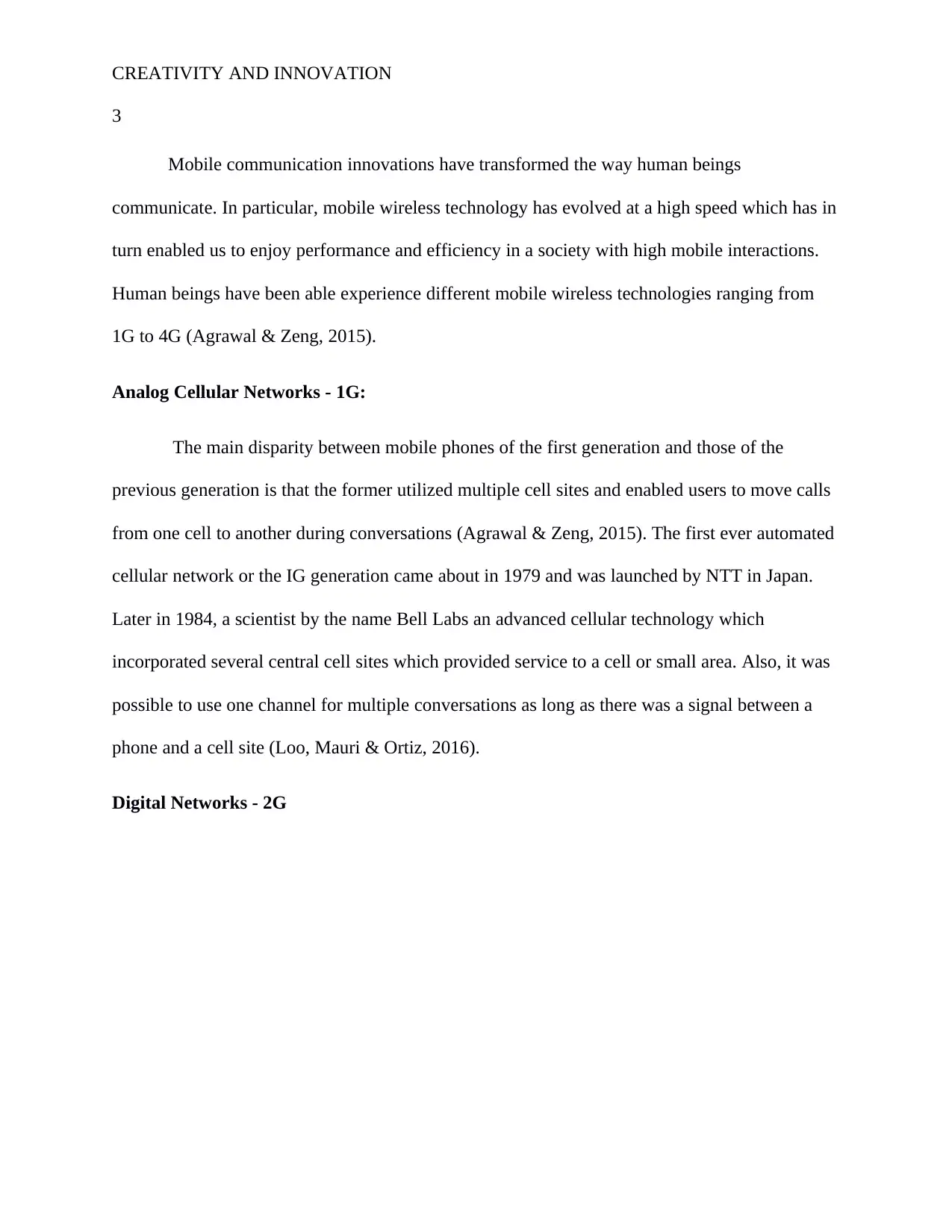
CREATIVITY AND INNOVATION
3
Mobile communication innovations have transformed the way human beings
communicate. In particular, mobile wireless technology has evolved at a high speed which has in
turn enabled us to enjoy performance and efficiency in a society with high mobile interactions.
Human beings have been able experience different mobile wireless technologies ranging from
1G to 4G (Agrawal & Zeng, 2015).
Analog Cellular Networks - 1G:
The main disparity between mobile phones of the first generation and those of the
previous generation is that the former utilized multiple cell sites and enabled users to move calls
from one cell to another during conversations (Agrawal & Zeng, 2015). The first ever automated
cellular network or the IG generation came about in 1979 and was launched by NTT in Japan.
Later in 1984, a scientist by the name Bell Labs an advanced cellular technology which
incorporated several central cell sites which provided service to a cell or small area. Also, it was
possible to use one channel for multiple conversations as long as there was a signal between a
phone and a cell site (Loo, Mauri & Ortiz, 2016).
Digital Networks - 2G
3
Mobile communication innovations have transformed the way human beings
communicate. In particular, mobile wireless technology has evolved at a high speed which has in
turn enabled us to enjoy performance and efficiency in a society with high mobile interactions.
Human beings have been able experience different mobile wireless technologies ranging from
1G to 4G (Agrawal & Zeng, 2015).
Analog Cellular Networks - 1G:
The main disparity between mobile phones of the first generation and those of the
previous generation is that the former utilized multiple cell sites and enabled users to move calls
from one cell to another during conversations (Agrawal & Zeng, 2015). The first ever automated
cellular network or the IG generation came about in 1979 and was launched by NTT in Japan.
Later in 1984, a scientist by the name Bell Labs an advanced cellular technology which
incorporated several central cell sites which provided service to a cell or small area. Also, it was
possible to use one channel for multiple conversations as long as there was a signal between a
phone and a cell site (Loo, Mauri & Ortiz, 2016).
Digital Networks - 2G
⊘ This is a preview!⊘
Do you want full access?
Subscribe today to unlock all pages.

Trusted by 1+ million students worldwide
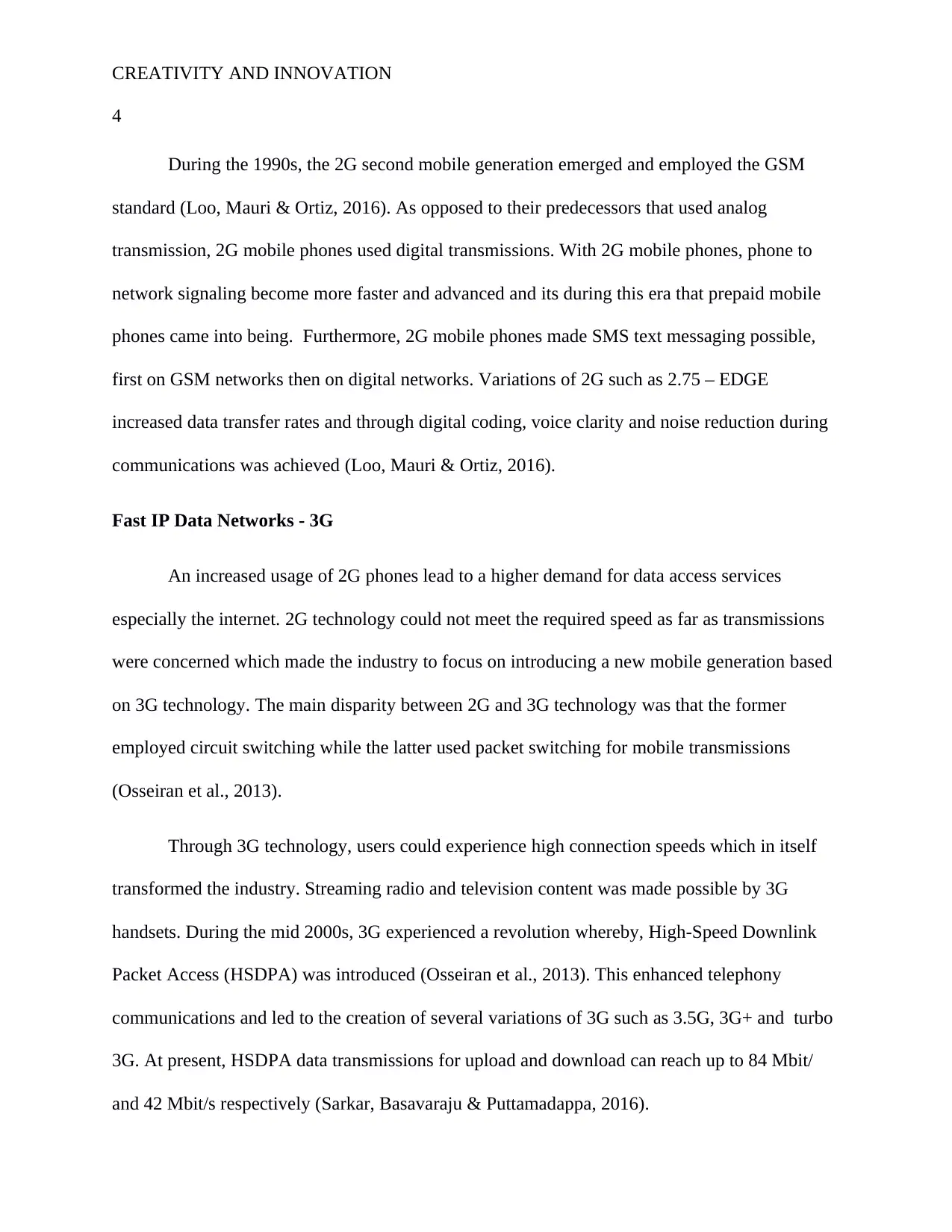
CREATIVITY AND INNOVATION
4
During the 1990s, the 2G second mobile generation emerged and employed the GSM
standard (Loo, Mauri & Ortiz, 2016). As opposed to their predecessors that used analog
transmission, 2G mobile phones used digital transmissions. With 2G mobile phones, phone to
network signaling become more faster and advanced and its during this era that prepaid mobile
phones came into being. Furthermore, 2G mobile phones made SMS text messaging possible,
first on GSM networks then on digital networks. Variations of 2G such as 2.75 – EDGE
increased data transfer rates and through digital coding, voice clarity and noise reduction during
communications was achieved (Loo, Mauri & Ortiz, 2016).
Fast IP Data Networks - 3G
An increased usage of 2G phones lead to a higher demand for data access services
especially the internet. 2G technology could not meet the required speed as far as transmissions
were concerned which made the industry to focus on introducing a new mobile generation based
on 3G technology. The main disparity between 2G and 3G technology was that the former
employed circuit switching while the latter used packet switching for mobile transmissions
(Osseiran et al., 2013).
Through 3G technology, users could experience high connection speeds which in itself
transformed the industry. Streaming radio and television content was made possible by 3G
handsets. During the mid 2000s, 3G experienced a revolution whereby, High-Speed Downlink
Packet Access (HSDPA) was introduced (Osseiran et al., 2013). This enhanced telephony
communications and led to the creation of several variations of 3G such as 3.5G, 3G+ and turbo
3G. At present, HSDPA data transmissions for upload and download can reach up to 84 Mbit/
and 42 Mbit/s respectively (Sarkar, Basavaraju & Puttamadappa, 2016).
4
During the 1990s, the 2G second mobile generation emerged and employed the GSM
standard (Loo, Mauri & Ortiz, 2016). As opposed to their predecessors that used analog
transmission, 2G mobile phones used digital transmissions. With 2G mobile phones, phone to
network signaling become more faster and advanced and its during this era that prepaid mobile
phones came into being. Furthermore, 2G mobile phones made SMS text messaging possible,
first on GSM networks then on digital networks. Variations of 2G such as 2.75 – EDGE
increased data transfer rates and through digital coding, voice clarity and noise reduction during
communications was achieved (Loo, Mauri & Ortiz, 2016).
Fast IP Data Networks - 3G
An increased usage of 2G phones lead to a higher demand for data access services
especially the internet. 2G technology could not meet the required speed as far as transmissions
were concerned which made the industry to focus on introducing a new mobile generation based
on 3G technology. The main disparity between 2G and 3G technology was that the former
employed circuit switching while the latter used packet switching for mobile transmissions
(Osseiran et al., 2013).
Through 3G technology, users could experience high connection speeds which in itself
transformed the industry. Streaming radio and television content was made possible by 3G
handsets. During the mid 2000s, 3G experienced a revolution whereby, High-Speed Downlink
Packet Access (HSDPA) was introduced (Osseiran et al., 2013). This enhanced telephony
communications and led to the creation of several variations of 3G such as 3.5G, 3G+ and turbo
3G. At present, HSDPA data transmissions for upload and download can reach up to 84 Mbit/
and 42 Mbit/s respectively (Sarkar, Basavaraju & Puttamadappa, 2016).
Paraphrase This Document
Need a fresh take? Get an instant paraphrase of this document with our AI Paraphraser
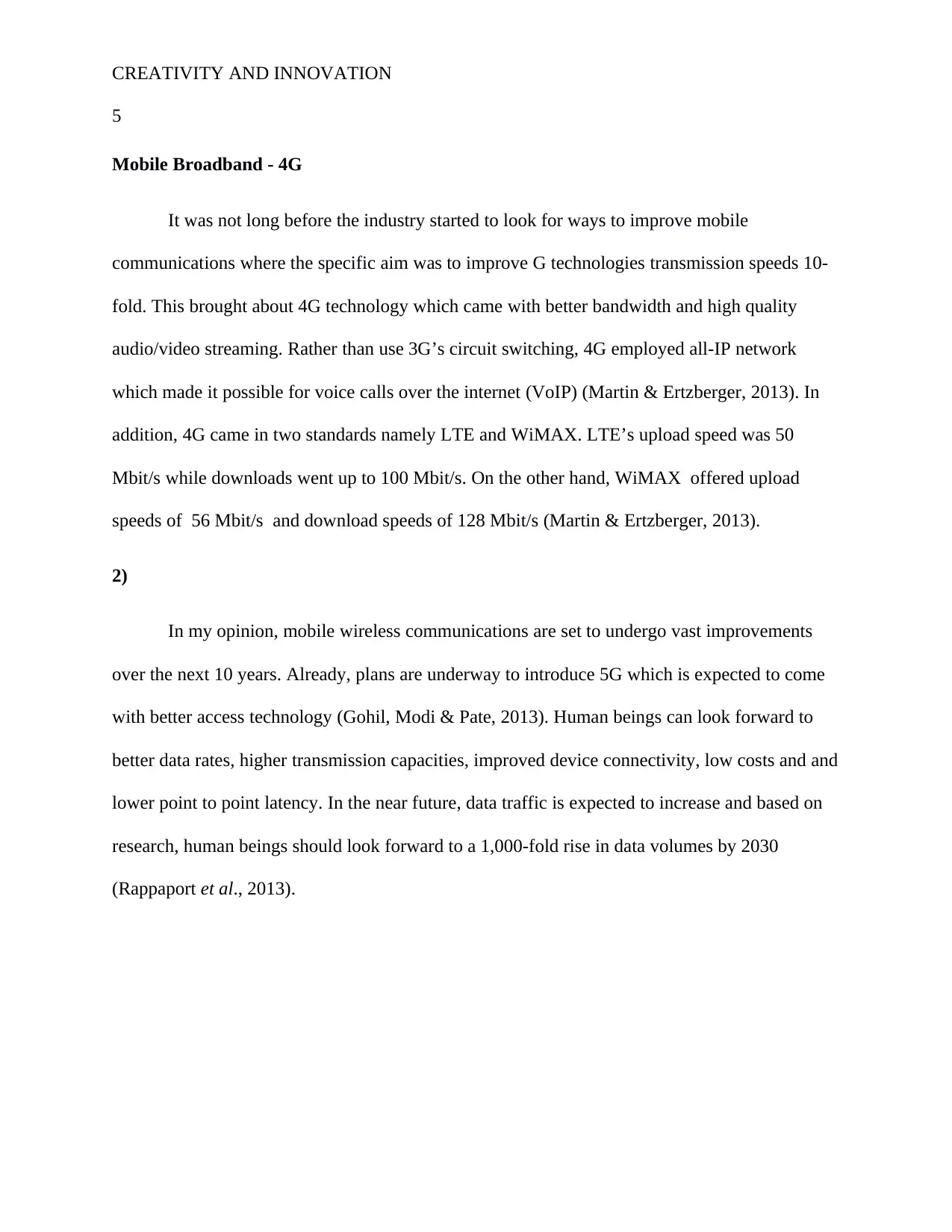
CREATIVITY AND INNOVATION
5
Mobile Broadband - 4G
It was not long before the industry started to look for ways to improve mobile
communications where the specific aim was to improve G technologies transmission speeds 10-
fold. This brought about 4G technology which came with better bandwidth and high quality
audio/video streaming. Rather than use 3G’s circuit switching, 4G employed all-IP network
which made it possible for voice calls over the internet (VoIP) (Martin & Ertzberger, 2013). In
addition, 4G came in two standards namely LTE and WiMAX. LTE’s upload speed was 50
Mbit/s while downloads went up to 100 Mbit/s. On the other hand, WiMAX offered upload
speeds of 56 Mbit/s and download speeds of 128 Mbit/s (Martin & Ertzberger, 2013).
2)
In my opinion, mobile wireless communications are set to undergo vast improvements
over the next 10 years. Already, plans are underway to introduce 5G which is expected to come
with better access technology (Gohil, Modi & Pate, 2013). Human beings can look forward to
better data rates, higher transmission capacities, improved device connectivity, low costs and and
lower point to point latency. In the near future, data traffic is expected to increase and based on
research, human beings should look forward to a 1,000-fold rise in data volumes by 2030
(Rappaport et al., 2013).
5
Mobile Broadband - 4G
It was not long before the industry started to look for ways to improve mobile
communications where the specific aim was to improve G technologies transmission speeds 10-
fold. This brought about 4G technology which came with better bandwidth and high quality
audio/video streaming. Rather than use 3G’s circuit switching, 4G employed all-IP network
which made it possible for voice calls over the internet (VoIP) (Martin & Ertzberger, 2013). In
addition, 4G came in two standards namely LTE and WiMAX. LTE’s upload speed was 50
Mbit/s while downloads went up to 100 Mbit/s. On the other hand, WiMAX offered upload
speeds of 56 Mbit/s and download speeds of 128 Mbit/s (Martin & Ertzberger, 2013).
2)
In my opinion, mobile wireless communications are set to undergo vast improvements
over the next 10 years. Already, plans are underway to introduce 5G which is expected to come
with better access technology (Gohil, Modi & Pate, 2013). Human beings can look forward to
better data rates, higher transmission capacities, improved device connectivity, low costs and and
lower point to point latency. In the near future, data traffic is expected to increase and based on
research, human beings should look forward to a 1,000-fold rise in data volumes by 2030
(Rappaport et al., 2013).
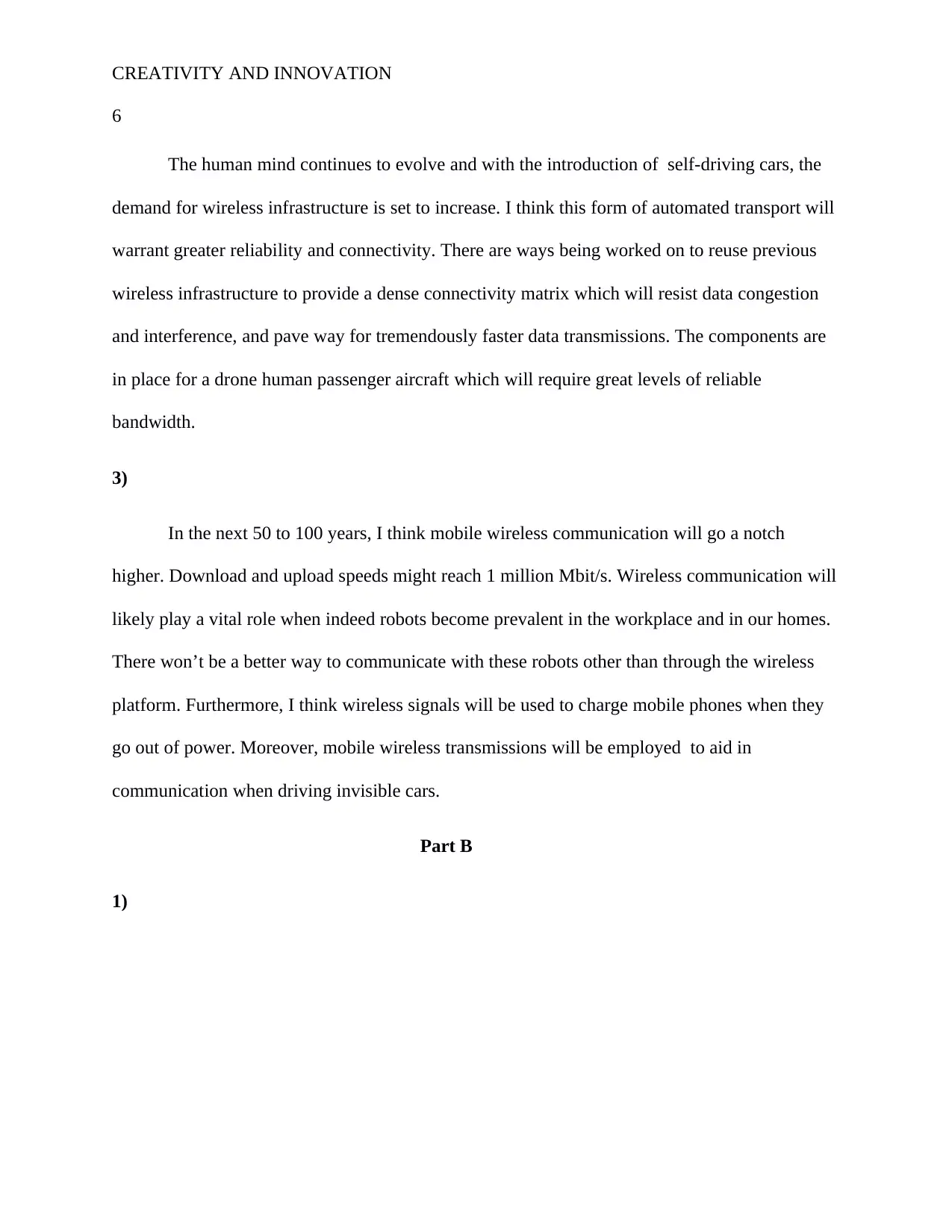
CREATIVITY AND INNOVATION
6
The human mind continues to evolve and with the introduction of self-driving cars, the
demand for wireless infrastructure is set to increase. I think this form of automated transport will
warrant greater reliability and connectivity. There are ways being worked on to reuse previous
wireless infrastructure to provide a dense connectivity matrix which will resist data congestion
and interference, and pave way for tremendously faster data transmissions. The components are
in place for a drone human passenger aircraft which will require great levels of reliable
bandwidth.
3)
In the next 50 to 100 years, I think mobile wireless communication will go a notch
higher. Download and upload speeds might reach 1 million Mbit/s. Wireless communication will
likely play a vital role when indeed robots become prevalent in the workplace and in our homes.
There won’t be a better way to communicate with these robots other than through the wireless
platform. Furthermore, I think wireless signals will be used to charge mobile phones when they
go out of power. Moreover, mobile wireless transmissions will be employed to aid in
communication when driving invisible cars.
Part B
1)
6
The human mind continues to evolve and with the introduction of self-driving cars, the
demand for wireless infrastructure is set to increase. I think this form of automated transport will
warrant greater reliability and connectivity. There are ways being worked on to reuse previous
wireless infrastructure to provide a dense connectivity matrix which will resist data congestion
and interference, and pave way for tremendously faster data transmissions. The components are
in place for a drone human passenger aircraft which will require great levels of reliable
bandwidth.
3)
In the next 50 to 100 years, I think mobile wireless communication will go a notch
higher. Download and upload speeds might reach 1 million Mbit/s. Wireless communication will
likely play a vital role when indeed robots become prevalent in the workplace and in our homes.
There won’t be a better way to communicate with these robots other than through the wireless
platform. Furthermore, I think wireless signals will be used to charge mobile phones when they
go out of power. Moreover, mobile wireless transmissions will be employed to aid in
communication when driving invisible cars.
Part B
1)
⊘ This is a preview!⊘
Do you want full access?
Subscribe today to unlock all pages.

Trusted by 1+ million students worldwide
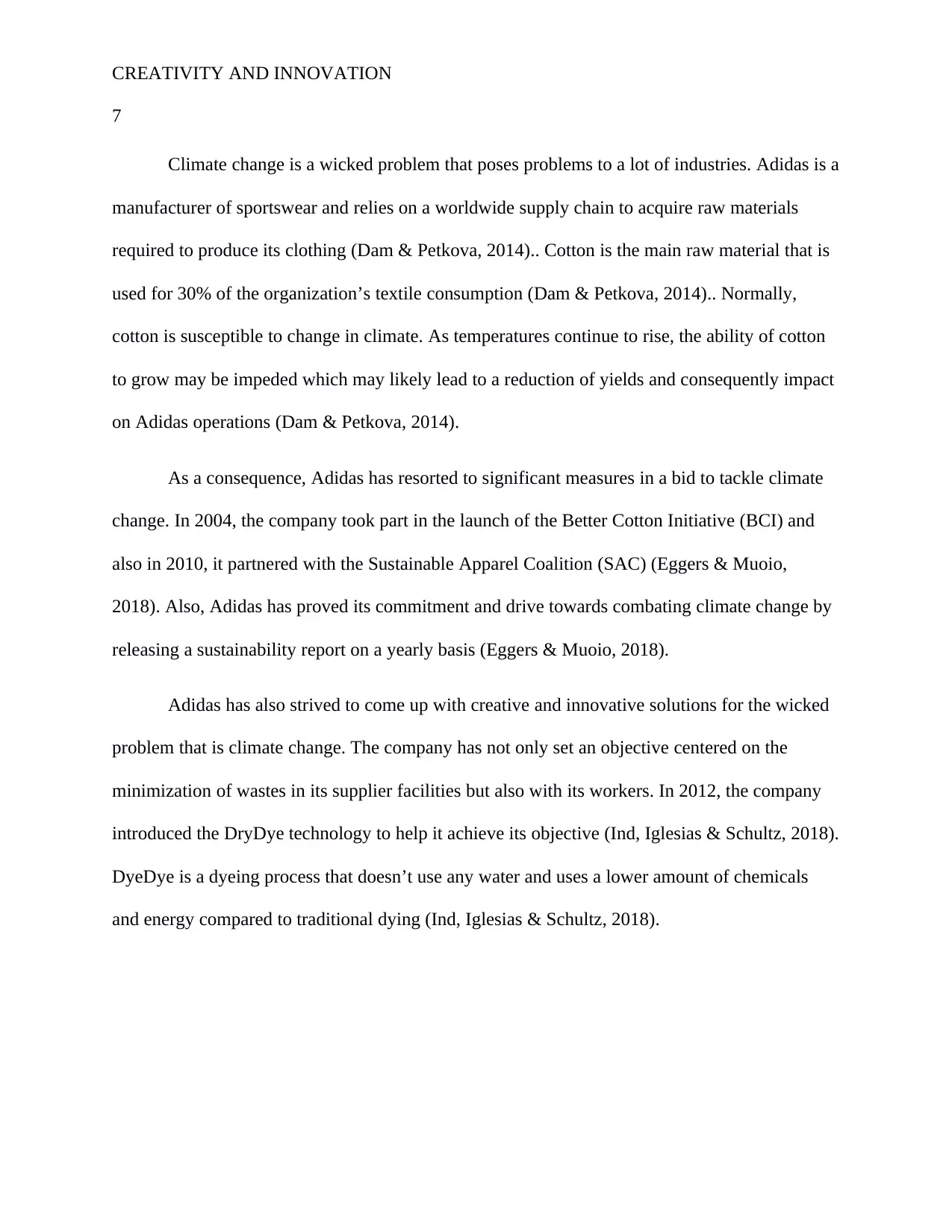
CREATIVITY AND INNOVATION
7
Climate change is a wicked problem that poses problems to a lot of industries. Adidas is a
manufacturer of sportswear and relies on a worldwide supply chain to acquire raw materials
required to produce its clothing (Dam & Petkova, 2014).. Cotton is the main raw material that is
used for 30% of the organization’s textile consumption (Dam & Petkova, 2014).. Normally,
cotton is susceptible to change in climate. As temperatures continue to rise, the ability of cotton
to grow may be impeded which may likely lead to a reduction of yields and consequently impact
on Adidas operations (Dam & Petkova, 2014).
As a consequence, Adidas has resorted to significant measures in a bid to tackle climate
change. In 2004, the company took part in the launch of the Better Cotton Initiative (BCI) and
also in 2010, it partnered with the Sustainable Apparel Coalition (SAC) (Eggers & Muoio,
2018). Also, Adidas has proved its commitment and drive towards combating climate change by
releasing a sustainability report on a yearly basis (Eggers & Muoio, 2018).
Adidas has also strived to come up with creative and innovative solutions for the wicked
problem that is climate change. The company has not only set an objective centered on the
minimization of wastes in its supplier facilities but also with its workers. In 2012, the company
introduced the DryDye technology to help it achieve its objective (Ind, Iglesias & Schultz, 2018).
DyeDye is a dyeing process that doesn’t use any water and uses a lower amount of chemicals
and energy compared to traditional dying (Ind, Iglesias & Schultz, 2018).
7
Climate change is a wicked problem that poses problems to a lot of industries. Adidas is a
manufacturer of sportswear and relies on a worldwide supply chain to acquire raw materials
required to produce its clothing (Dam & Petkova, 2014).. Cotton is the main raw material that is
used for 30% of the organization’s textile consumption (Dam & Petkova, 2014).. Normally,
cotton is susceptible to change in climate. As temperatures continue to rise, the ability of cotton
to grow may be impeded which may likely lead to a reduction of yields and consequently impact
on Adidas operations (Dam & Petkova, 2014).
As a consequence, Adidas has resorted to significant measures in a bid to tackle climate
change. In 2004, the company took part in the launch of the Better Cotton Initiative (BCI) and
also in 2010, it partnered with the Sustainable Apparel Coalition (SAC) (Eggers & Muoio,
2018). Also, Adidas has proved its commitment and drive towards combating climate change by
releasing a sustainability report on a yearly basis (Eggers & Muoio, 2018).
Adidas has also strived to come up with creative and innovative solutions for the wicked
problem that is climate change. The company has not only set an objective centered on the
minimization of wastes in its supplier facilities but also with its workers. In 2012, the company
introduced the DryDye technology to help it achieve its objective (Ind, Iglesias & Schultz, 2018).
DyeDye is a dyeing process that doesn’t use any water and uses a lower amount of chemicals
and energy compared to traditional dying (Ind, Iglesias & Schultz, 2018).
Paraphrase This Document
Need a fresh take? Get an instant paraphrase of this document with our AI Paraphraser
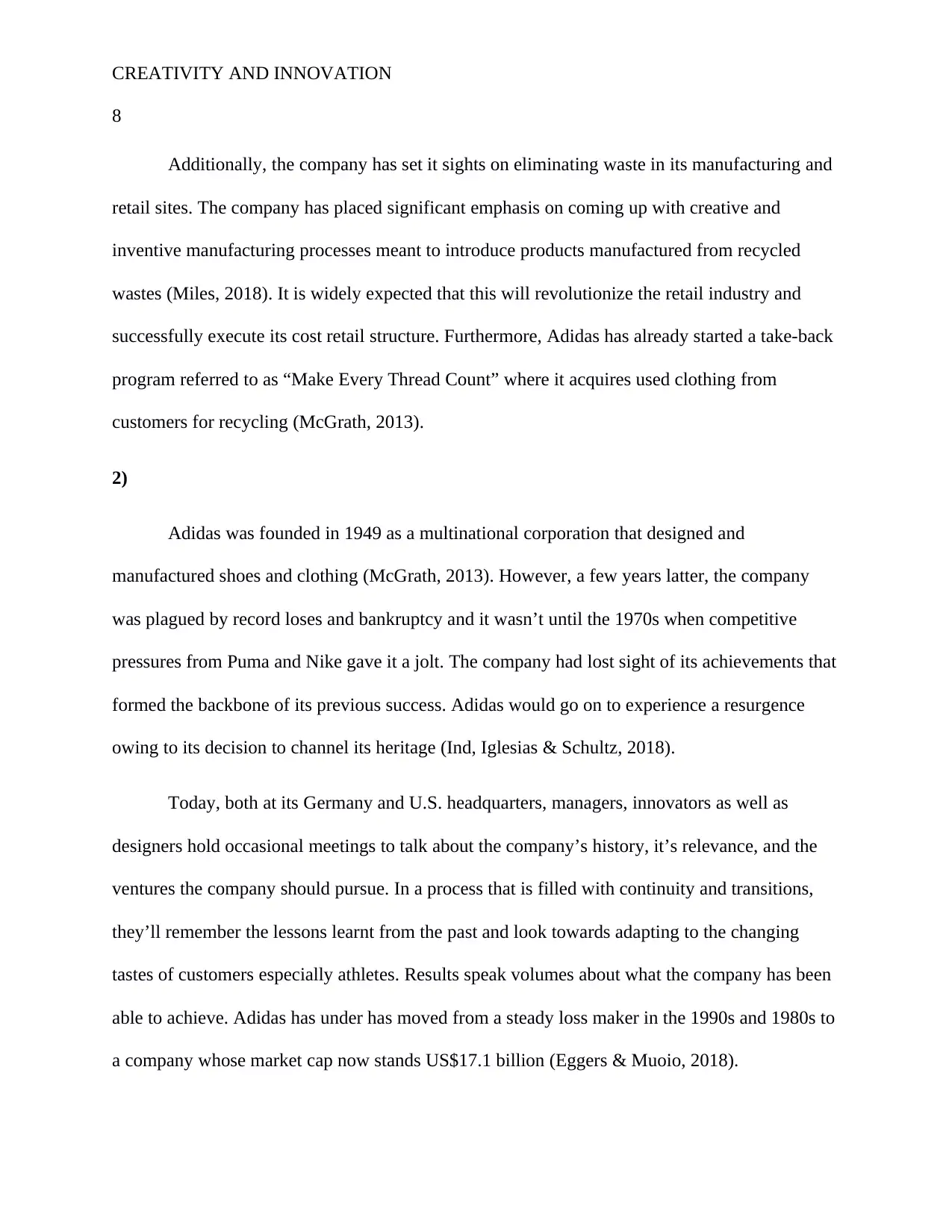
CREATIVITY AND INNOVATION
8
Additionally, the company has set it sights on eliminating waste in its manufacturing and
retail sites. The company has placed significant emphasis on coming up with creative and
inventive manufacturing processes meant to introduce products manufactured from recycled
wastes (Miles, 2018). It is widely expected that this will revolutionize the retail industry and
successfully execute its cost retail structure. Furthermore, Adidas has already started a take-back
program referred to as “Make Every Thread Count” where it acquires used clothing from
customers for recycling (McGrath, 2013).
2)
Adidas was founded in 1949 as a multinational corporation that designed and
manufactured shoes and clothing (McGrath, 2013). However, a few years latter, the company
was plagued by record loses and bankruptcy and it wasn’t until the 1970s when competitive
pressures from Puma and Nike gave it a jolt. The company had lost sight of its achievements that
formed the backbone of its previous success. Adidas would go on to experience a resurgence
owing to its decision to channel its heritage (Ind, Iglesias & Schultz, 2018).
Today, both at its Germany and U.S. headquarters, managers, innovators as well as
designers hold occasional meetings to talk about the company’s history, it’s relevance, and the
ventures the company should pursue. In a process that is filled with continuity and transitions,
they’ll remember the lessons learnt from the past and look towards adapting to the changing
tastes of customers especially athletes. Results speak volumes about what the company has been
able to achieve. Adidas has under has moved from a steady loss maker in the 1990s and 1980s to
a company whose market cap now stands US$17.1 billion (Eggers & Muoio, 2018).
8
Additionally, the company has set it sights on eliminating waste in its manufacturing and
retail sites. The company has placed significant emphasis on coming up with creative and
inventive manufacturing processes meant to introduce products manufactured from recycled
wastes (Miles, 2018). It is widely expected that this will revolutionize the retail industry and
successfully execute its cost retail structure. Furthermore, Adidas has already started a take-back
program referred to as “Make Every Thread Count” where it acquires used clothing from
customers for recycling (McGrath, 2013).
2)
Adidas was founded in 1949 as a multinational corporation that designed and
manufactured shoes and clothing (McGrath, 2013). However, a few years latter, the company
was plagued by record loses and bankruptcy and it wasn’t until the 1970s when competitive
pressures from Puma and Nike gave it a jolt. The company had lost sight of its achievements that
formed the backbone of its previous success. Adidas would go on to experience a resurgence
owing to its decision to channel its heritage (Ind, Iglesias & Schultz, 2018).
Today, both at its Germany and U.S. headquarters, managers, innovators as well as
designers hold occasional meetings to talk about the company’s history, it’s relevance, and the
ventures the company should pursue. In a process that is filled with continuity and transitions,
they’ll remember the lessons learnt from the past and look towards adapting to the changing
tastes of customers especially athletes. Results speak volumes about what the company has been
able to achieve. Adidas has under has moved from a steady loss maker in the 1990s and 1980s to
a company whose market cap now stands US$17.1 billion (Eggers & Muoio, 2018).
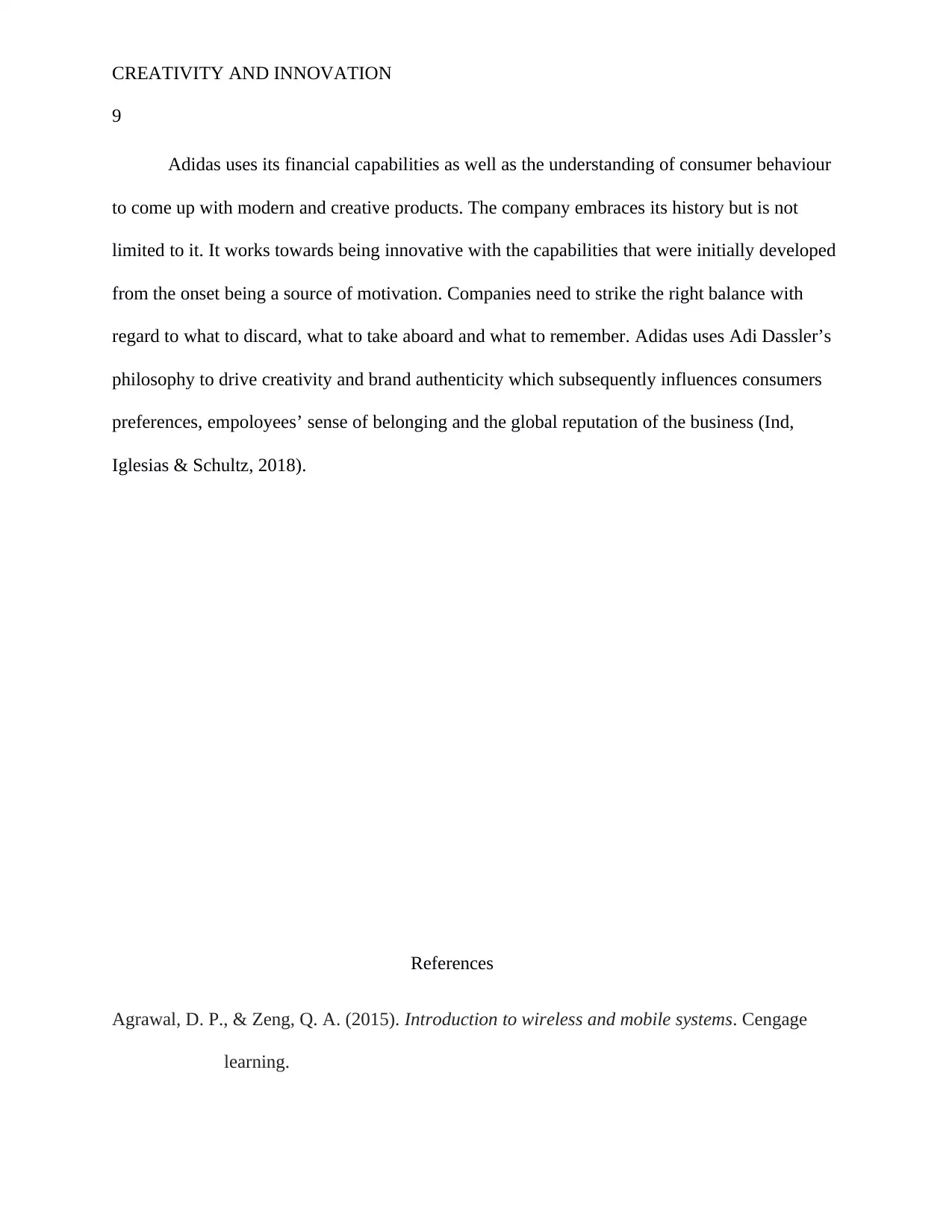
CREATIVITY AND INNOVATION
9
Adidas uses its financial capabilities as well as the understanding of consumer behaviour
to come up with modern and creative products. The company embraces its history but is not
limited to it. It works towards being innovative with the capabilities that were initially developed
from the onset being a source of motivation. Companies need to strike the right balance with
regard to what to discard, what to take aboard and what to remember. Adidas uses Adi Dassler’s
philosophy to drive creativity and brand authenticity which subsequently influences consumers
preferences, empoloyees’ sense of belonging and the global reputation of the business (Ind,
Iglesias & Schultz, 2018).
References
Agrawal, D. P., & Zeng, Q. A. (2015). Introduction to wireless and mobile systems. Cengage
learning.
9
Adidas uses its financial capabilities as well as the understanding of consumer behaviour
to come up with modern and creative products. The company embraces its history but is not
limited to it. It works towards being innovative with the capabilities that were initially developed
from the onset being a source of motivation. Companies need to strike the right balance with
regard to what to discard, what to take aboard and what to remember. Adidas uses Adi Dassler’s
philosophy to drive creativity and brand authenticity which subsequently influences consumers
preferences, empoloyees’ sense of belonging and the global reputation of the business (Ind,
Iglesias & Schultz, 2018).
References
Agrawal, D. P., & Zeng, Q. A. (2015). Introduction to wireless and mobile systems. Cengage
learning.
⊘ This is a preview!⊘
Do you want full access?
Subscribe today to unlock all pages.

Trusted by 1+ million students worldwide
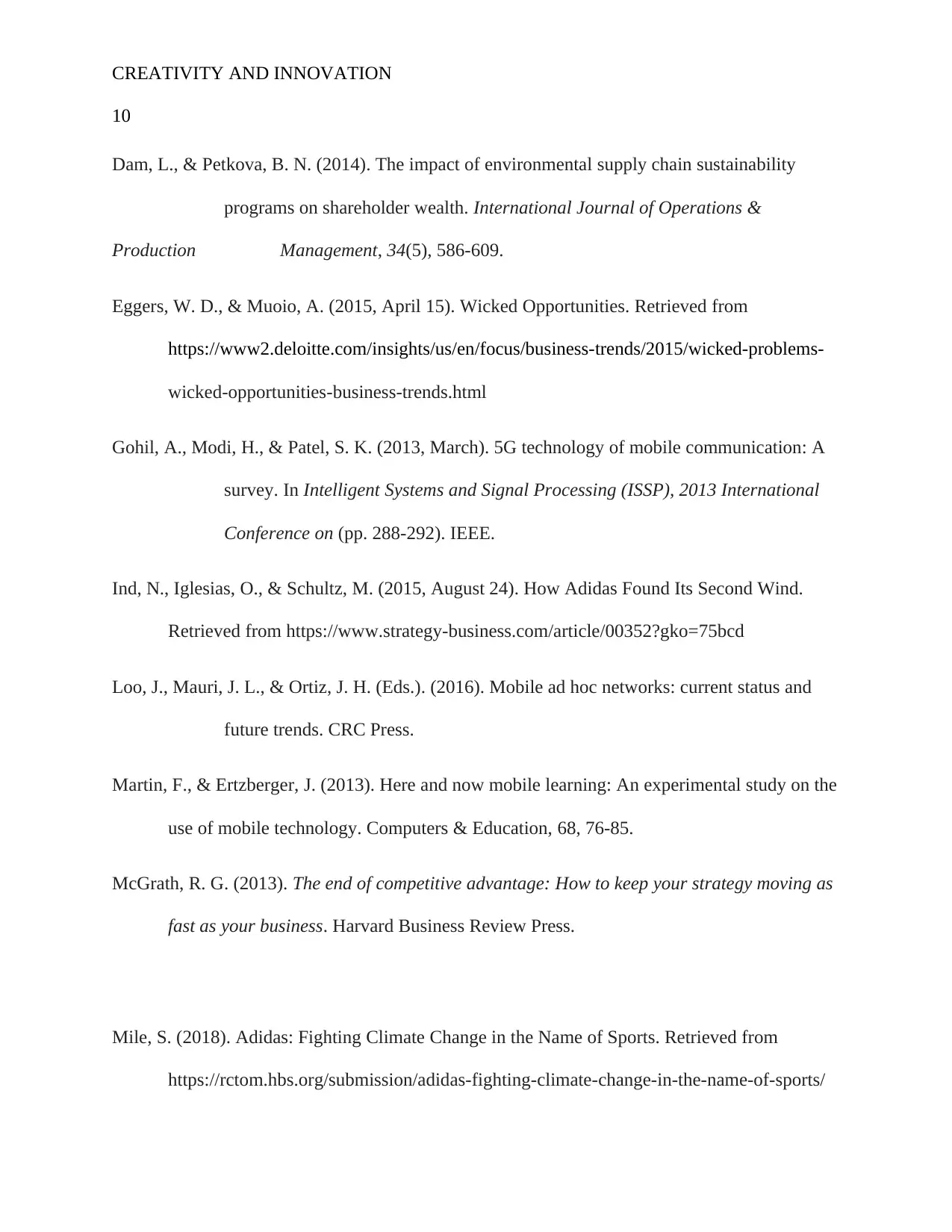
CREATIVITY AND INNOVATION
10
Dam, L., & Petkova, B. N. (2014). The impact of environmental supply chain sustainability
programs on shareholder wealth. International Journal of Operations &
Production Management, 34(5), 586-609.
Eggers, W. D., & Muoio, A. (2015, April 15). Wicked Opportunities. Retrieved from
https://www2.deloitte.com/insights/us/en/focus/business-trends/2015/wicked-problems-
wicked-opportunities-business-trends.html
Gohil, A., Modi, H., & Patel, S. K. (2013, March). 5G technology of mobile communication: A
survey. In Intelligent Systems and Signal Processing (ISSP), 2013 International
Conference on (pp. 288-292). IEEE.
Ind, N., Iglesias, O., & Schultz, M. (2015, August 24). How Adidas Found Its Second Wind.
Retrieved from https://www.strategy-business.com/article/00352?gko=75bcd
Loo, J., Mauri, J. L., & Ortiz, J. H. (Eds.). (2016). Mobile ad hoc networks: current status and
future trends. CRC Press.
Martin, F., & Ertzberger, J. (2013). Here and now mobile learning: An experimental study on the
use of mobile technology. Computers & Education, 68, 76-85.
McGrath, R. G. (2013). The end of competitive advantage: How to keep your strategy moving as
fast as your business. Harvard Business Review Press.
Mile, S. (2018). Adidas: Fighting Climate Change in the Name of Sports. Retrieved from
https://rctom.hbs.org/submission/adidas-fighting-climate-change-in-the-name-of-sports/
10
Dam, L., & Petkova, B. N. (2014). The impact of environmental supply chain sustainability
programs on shareholder wealth. International Journal of Operations &
Production Management, 34(5), 586-609.
Eggers, W. D., & Muoio, A. (2015, April 15). Wicked Opportunities. Retrieved from
https://www2.deloitte.com/insights/us/en/focus/business-trends/2015/wicked-problems-
wicked-opportunities-business-trends.html
Gohil, A., Modi, H., & Patel, S. K. (2013, March). 5G technology of mobile communication: A
survey. In Intelligent Systems and Signal Processing (ISSP), 2013 International
Conference on (pp. 288-292). IEEE.
Ind, N., Iglesias, O., & Schultz, M. (2015, August 24). How Adidas Found Its Second Wind.
Retrieved from https://www.strategy-business.com/article/00352?gko=75bcd
Loo, J., Mauri, J. L., & Ortiz, J. H. (Eds.). (2016). Mobile ad hoc networks: current status and
future trends. CRC Press.
Martin, F., & Ertzberger, J. (2013). Here and now mobile learning: An experimental study on the
use of mobile technology. Computers & Education, 68, 76-85.
McGrath, R. G. (2013). The end of competitive advantage: How to keep your strategy moving as
fast as your business. Harvard Business Review Press.
Mile, S. (2018). Adidas: Fighting Climate Change in the Name of Sports. Retrieved from
https://rctom.hbs.org/submission/adidas-fighting-climate-change-in-the-name-of-sports/
Paraphrase This Document
Need a fresh take? Get an instant paraphrase of this document with our AI Paraphraser
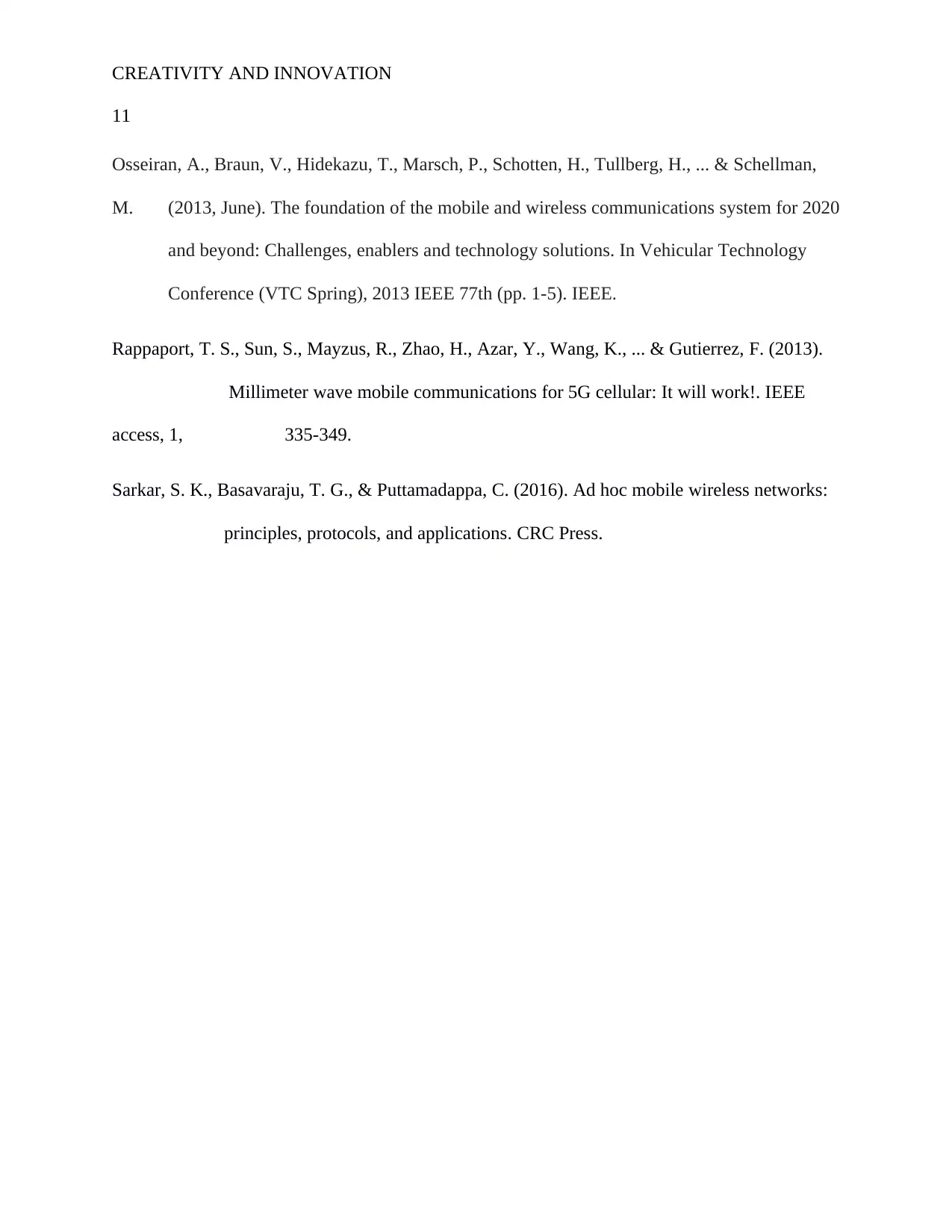
CREATIVITY AND INNOVATION
11
Osseiran, A., Braun, V., Hidekazu, T., Marsch, P., Schotten, H., Tullberg, H., ... & Schellman,
M. (2013, June). The foundation of the mobile and wireless communications system for 2020
and beyond: Challenges, enablers and technology solutions. In Vehicular Technology
Conference (VTC Spring), 2013 IEEE 77th (pp. 1-5). IEEE.
Rappaport, T. S., Sun, S., Mayzus, R., Zhao, H., Azar, Y., Wang, K., ... & Gutierrez, F. (2013).
Millimeter wave mobile communications for 5G cellular: It will work!. IEEE
access, 1, 335-349.
Sarkar, S. K., Basavaraju, T. G., & Puttamadappa, C. (2016). Ad hoc mobile wireless networks:
principles, protocols, and applications. CRC Press.
11
Osseiran, A., Braun, V., Hidekazu, T., Marsch, P., Schotten, H., Tullberg, H., ... & Schellman,
M. (2013, June). The foundation of the mobile and wireless communications system for 2020
and beyond: Challenges, enablers and technology solutions. In Vehicular Technology
Conference (VTC Spring), 2013 IEEE 77th (pp. 1-5). IEEE.
Rappaport, T. S., Sun, S., Mayzus, R., Zhao, H., Azar, Y., Wang, K., ... & Gutierrez, F. (2013).
Millimeter wave mobile communications for 5G cellular: It will work!. IEEE
access, 1, 335-349.
Sarkar, S. K., Basavaraju, T. G., & Puttamadappa, C. (2016). Ad hoc mobile wireless networks:
principles, protocols, and applications. CRC Press.
1 out of 11
Related Documents
Your All-in-One AI-Powered Toolkit for Academic Success.
+13062052269
info@desklib.com
Available 24*7 on WhatsApp / Email
![[object Object]](/_next/static/media/star-bottom.7253800d.svg)
Unlock your academic potential
Copyright © 2020–2025 A2Z Services. All Rights Reserved. Developed and managed by ZUCOL.





